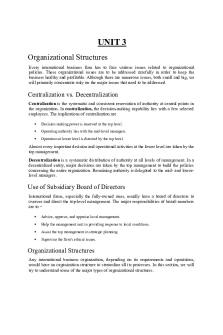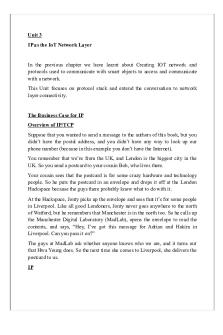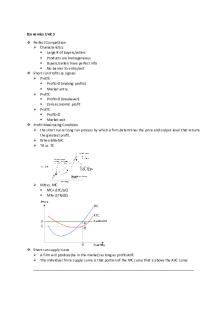UNIT 3 - SOA - NOTES FOR SERVICE ORIENTED ARCHITECTURE PDF

| Title | UNIT 3 - SOA - NOTES FOR SERVICE ORIENTED ARCHITECTURE |
|---|---|
| Author | taashu fashions |
| Course | service oriented architecture |
| Institution | SRM Institute of Science and Technology |
| Pages | 17 |
| File Size | 1.7 MB |
| File Type | |
| Total Downloads | 4 |
| Total Views | 182 |
Summary
NOTES FOR SERVICE ORIENTED ARCHITECTURE...
Description
UNIT 3 CHARACTERISTICS OF SOA
2. Contemporary SOA increases quality of service To fill QoS gap of primitive SOA the contemporary SOA provides following features Contemporary SOA provides: provides security through WS-Security, WS-policy, WS-Encryption o provides reliability through WSReliableMessaging protects business integrity through WS-AtomicTransaction 3. Contemporary SOA is fundamentally autonomous It should Offers message level autonomy: messages passed between services are intelligence-heavy that they can control the manner in which they are processed by recipient services
4. Contemporary SOA is based on open standard SOA uses open standard protocols such as SOAP, WSDL, UDDI, XML, XML Schema to exchange message between services. This supports loose coupling between services.
5.Contemporary SOA suppo rts vendor diversity The open communications framework bridging much of the heterogeneity within (and between) corporation s 6. Contemporary SOA promo tes discovery -
Contemporary SOA supports the advertisement and discovery of services throughout the enterprise and beyond - UDDI offers service registr y or directory to manage service description 7. Contemporary SOA foster interoperability Contemporary SOA enhance interoperability in the heterogeneous us environment through: o The required us age of open standards such as SOA P, UDDI, WSDL protocols and SOAP messages
8. Contemporary SOA promo tes federation - SOA enables stanadardize d federation of legacy and non-legacy application logic by encapsulating it and by exposing it via common, open, and standardized communications framewor k 9. Contemporary SOA promo tes architectural composability - Web service framework increase architectural composability thro ugh the release of WS-* specification which enhance standardization of SOAP message, which increases interoperability between services. This facilitates construction of new services by combining exist ing services. 10.Contemporary SOA foster inherent reusability Service oriented design principle encourages the reuse of ser vices. Multiple services can be combined into larger services, which in turn can be reused 11.Contemporary SOA empha sizes extensibility Extensible servic es can expand functionality with minim al impact
12.Contemporary SOA suppo rts a service-oriented business modelin g paradigm - Services can be designe d to express business logic. BPM(Business Process Management) models, en tity models, and other forms of business intelligence can be accurately represe nted through the coordinated composition of business-centric services by encapsu lating business process logic within services 13.Contemporary SOA imple ments layers of abstraction SOA introduces layer of abstraction by positioning service as a ccess point to various resources and business process logic. 14. Contemporary SOA pro motes loose coupling throughout the en terprise By implementing service abstraction layers, a loosely coupled relationship can be achieved between the business and application technology domains of an enterprise 15.Contemporary SOA promotes organizational agility -
Organizational agility refers to efficiency with which an organizati on can respond to changes immediately. 16.Contemporary SOA is a building block Two or more services can be composed into larger service. Multiple SOA applications can be pulled into service oriented integration technology to help to build the application of SOE(Service Oriented Enterprise) 17.Contemporary SOA is is an evolution - SOA is the distinct architecture from its predecessors such as client server architecture, distributed architecture such as COM+, RMI and CORBA 18.Contemporary SOA is an evolution is still maturing - Standards organizations and major software vendors have produced many specifications to address a variety of supplementary extensions - To improve QoS, lot of WS_Extensions are keep on released 19.Contemporary SOA is an achievable ideal - Moving an enterprise towards SOA is difficult and enormous task. Many organizations begin within single application and expanding service to other applications. Moving to SOA requires cultural changes in organization.
SOA VS CLIENT SERVER ARCHITECTURE AND DISTRIBUTED INTERNET ARCHITECTURE
SOA VS CLIENT SERVER ARCHITECTURE
SOA VS DISTRIBUTED INTERNET ARCHITECTURE
(i) Improved Integration and increased Interoperability - Vendor-neutral communications framework established by Web services-driven SOAs, allows enterprises to implement highly standardized service descriptions and message structures. This result in increased Interoperability (ii) Inherent reuse - Service-orientation promotes the design of services that are inherently reusable (iii) Streamlined architectures and solutions - The concept of composition is another fundamental part of SOA. The compositon is not, limited to the assembly of service collections into aggregate services. The WS-* (WSExtensibility) platform is based on the principle of composability (iv) Leveraging the legacy investment and facilitates federation of legacy system - The industry-wide acceptance of the Web services technology leads to large market adaption, enabling many legacy environments to participate in service-oriented integration architectures. (v) Establishing standardized XML data representation - The entire SOA is built upon and driven by XML - As a result, an adoption of SOA leads to the opportunity to fully leverage the XML data representation platform (vi) Focused investment on communications infrastructure (vii) SOA introduce a standardized communication protocols such as SOAP, XML, WSDL, UDDI, which allows software organization to adopt single communication technology. (vii)"Best-of-breed" alternatives - Since SOA support cross product interoperability, the software consumer can buy and use the best products in the market with minimum cost and more feature (viii) improve Organizational agility - Organizational agility refers to efficiency with which an organization can respond to changes immediately. Other benefit includes: 1. Messaging With SOA, one software service can invoke other software service by exchanging SOAP message. This facilitates cross product integration 2. Complex Event processing(CEP) 3. Service composition -
Constructing or combining more than one service to consult a complex service is referred as Service composition. There are two styles of service composition a) Orchestration b) Choreography
4. Asset wrapping -
CPU, Hard disk, software are considered as IT assets of an enterprise.
5. Virtualization -
virtualization can be used to enable program tat were written to use one asset can be executed with different asset
PRINCIPLES OF SERVICE ORIENTATION
SERVICE COUPLING
SERVICE DISCOVERABILITY
SERVICE COMPOSABILITY
SERVICE LAYERS While the service-orientation concepts we covered in the previous c hapter are what fundamentally define SOA , they are still just theory. To bring service-orientation into a real-life automation solution, we need to provide an environ ment capable of supporting its fundamental principles. The Web services framew ork provides us with the technology and the design paradigm with which we c an bring service-orientation into a real- life automation solution The following section form s an approach for structuring and delivering specialized service layers around the delivery of contemporary SOA characteristics Service-orientation and contemporary SOA Contemporary SOA is a complex and sophisticated architectural platform that offers significant potential to solve many historic and current IT problems The primary external influences that shape and affect contemporary SOA are o first-generation We b services specifications o second-generation (WS-*) Web Services specifications o principles of service-orientation Figure: External influences that form and support contemporary SOA.
There are, of course, many other influences. Fundamental XM L concepts, for example, have driven and shaped SOA and Web services on a fundamental level Unsupported SOA characteristics The following six SOA characteristics that does not receive support from our identified external influences: o intrinsic Interoperability o extensibility
o o o o
enterprise-wide loose coupling service-oriented business modeling organizational agility layers of abstraction
The following four remaining characteristics of contemporary SOA that are not directly supported or provided by the external influences: 1. enterprise-wide loose coupling 2. support for service-oriented business modeling 3. organizational agility 4. layers of abstraction Those characteristics that are not directly supplied by these influences must be realized through dedicated modeling and design effort
SERVICE LAYER ABSTRACTION Layers of Abstraction “layers of abstraction” is happens to be the last of our four ou tstanding SOA characteristics. By leveraging the concept of composition, we can build specia lized layers of services. Each layer can abstract a specific aspect of our solution, addressing one of the issues we identified The three layers of abstraction we identified for SOA are: The application service layer The business service layer The orchestration service layer Each of these layers shown in the following figure: The three primary service layers
business Process se rvices
service
application services
(i)
Application service lay er
The application service layer consists of application services that represent technology-specific logic. Services that reside within this layer can be referred to as application services.
Typical incarnations of application services are the utility and wrapper models described below: o utility service When a separate business service layer exists,then turn all application services into generic utility services o wrapper service Wrapper services most often are utilized for integration purposes. They consist of services that encapsulate ("wrap") some or all parts of a legacy environment to expose legacy functionality to service requestors o proxy service Another variation of the wrapper service model is the proxy service
(ii)
This is also known as an auto-generated WSDL. This simply provides a WSDL definition that mirrors an existing component interface Business service layer
The business service layer introduces a service concerned solely with representing business logic. The service running in this layer is called business service Business service layer abstraction leads to the creation of two further business service models: o Task-centric business service A service that encapsulates business logic specific to a task or business process. Task-centric business services have limited reuse potential. o Entity-centric business service A service that encapsulates a specific business entity (such as an invoice or timesheet). (iii)
Orchestration service layer
Orchestration is more valuable to us than a standard business process, as it allows us to directly link process logic to service interaction within our workflow logic This combines business process modeling with service-oriented modeling and design Orchestration brings the business process into the service layer, positioning it as a master composition controller.
The orchestration service layer introduces a parent level of abstraction to ensure that service operations are executed in a specific sequence. This promotes agility and reusability...
Similar Free PDFs

Unit-4 IT6801 SOA - unit 4 notes
- 38 Pages

Unit-5 IT6801 SOA
- 62 Pages

Unit 3 - A worksheet for unit 3
- 3 Pages

Unit 3 Textbook Notes
- 29 Pages

Sdm-unit 3 - notes
- 35 Pages

UE18CS313 UNIT 3 Notes
- 47 Pages

HHD UNIT 3 - notes
- 43 Pages

Unit 3 Notes
- 7 Pages

Unit-3-Notes - Lecture notes 3
- 12 Pages
Popular Institutions
- Tinajero National High School - Annex
- Politeknik Caltex Riau
- Yokohama City University
- SGT University
- University of Al-Qadisiyah
- Divine Word College of Vigan
- Techniek College Rotterdam
- Universidade de Santiago
- Universiti Teknologi MARA Cawangan Johor Kampus Pasir Gudang
- Poltekkes Kemenkes Yogyakarta
- Baguio City National High School
- Colegio san marcos
- preparatoria uno
- Centro de Bachillerato Tecnológico Industrial y de Servicios No. 107
- Dalian Maritime University
- Quang Trung Secondary School
- Colegio Tecnológico en Informática
- Corporación Regional de Educación Superior
- Grupo CEDVA
- Dar Al Uloom University
- Centro de Estudios Preuniversitarios de la Universidad Nacional de Ingeniería
- 上智大学
- Aakash International School, Nuna Majara
- San Felipe Neri Catholic School
- Kang Chiao International School - New Taipei City
- Misamis Occidental National High School
- Institución Educativa Escuela Normal Juan Ladrilleros
- Kolehiyo ng Pantukan
- Batanes State College
- Instituto Continental
- Sekolah Menengah Kejuruan Kesehatan Kaltara (Tarakan)
- Colegio de La Inmaculada Concepcion - Cebu






